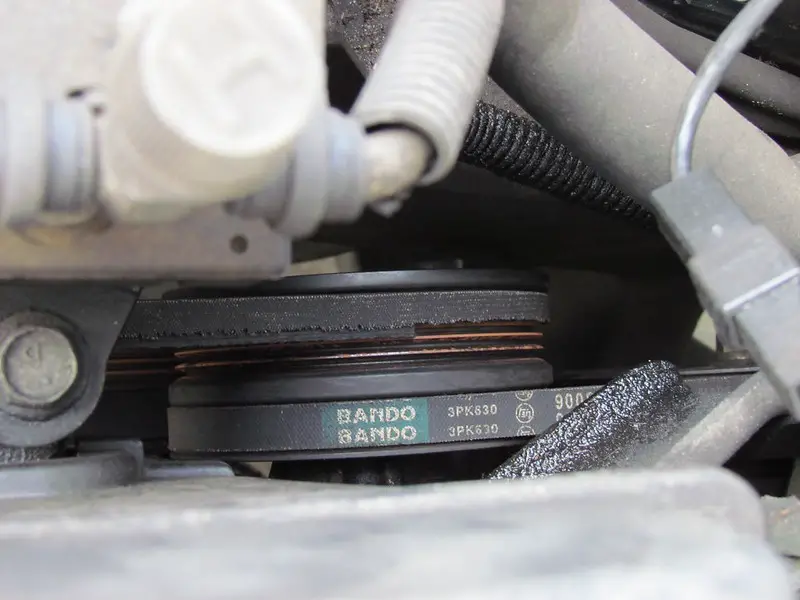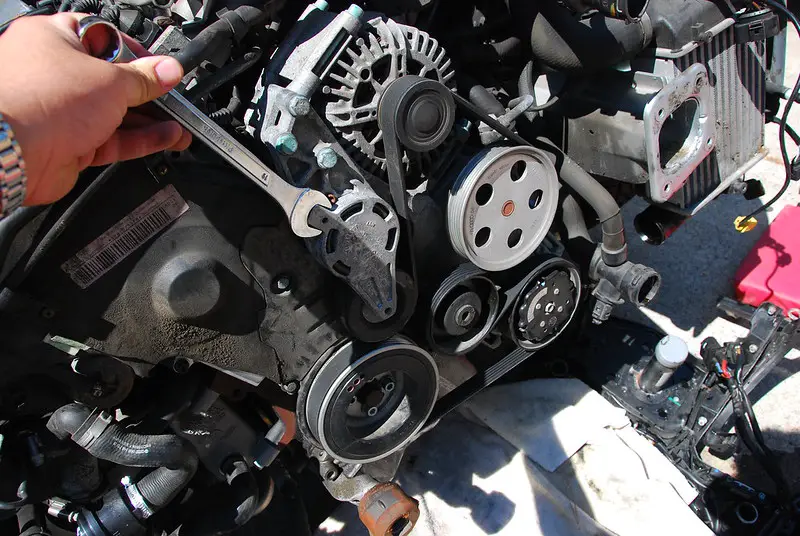Serpentine belts are more cost-effective and easy to maintain but can be noisy when the engine is in motion. Timing belts are much quieter and provide increased power output, but they require more maintenance over time.
What is a serpentine belt?
A serpentine belt is a type of flat belt that is used on many different types of vehicles. The serpentine belt is used to drive the accessories that are located on the engine. The serpentine belt is made up of several different ribs that are connected together. The ribs help to keep the belt in place and to prevent the belt from slipping.
What is a timing belt?
(Picure By Bozart2000 on Flickr)

A timing belt is a belt that connects the engine crankshaft to the camshaft, ensuring that the valves open and close at the correct times. The timing belt is located in front of the engine and is usually made of rubber with teeth that mesh with pulleys on the crank and cam shafts. Over time, the timing belt can stretch or wear out, causing the engine to run poorly.
The difference between serpentine belt and timing belt
The serpentine belt is a belt that drives all of the accessories in an engine, while the timing belt is a belt that synchronizes the camshaft and crankshaft in order to ensure proper valve timing. The serpentine belt is located at the front of the engine, while the timing belt is located at the back of the engine.
When to replace your timing belt
The timing belt is a crucial part of your engine, and it needs to be replaced at the recommended interval to avoid serious engine damage. Most manufacturers recommend replacing the timing belt every 60,000 miles or 5 years, whichever comes first. If you drive in stop-and-go traffic or in dusty conditions, you may need to replace your timing belt more often.
How to know if your serpentine belt needs to be replaced
(Photo By Nick Nguyen on Flickr)

The serpentine belt is an important component of a car’s engine system, and it helps to power many of the vehicle’s accessories, such as the alternator, power steering pump, and air conditioning compressor. Here are some signs that your serpentine belt may need to be replaced:
- Squeaking or chirping noise: If you hear a squeaking or chirping noise coming from the engine area while the car is running, it could be a sign that the serpentine belt is worn or damaged.
- Cracks or fraying: Inspect the serpentine belt for any signs of cracks, fraying, or other damage. Over time, the rubber can deteriorate, and the belt can become brittle or weakened, leading to potential failure.
- Glazing or shiny appearance: If the belt appears shiny or glazed, it could be a sign of excessive wear or overheating, which can cause the belt to slip or break.
- Accessories not working: If one or more of the car’s accessories, such as the air conditioning or power steering, stop working or perform poorly, it could be due to a failing serpentine belt.
- Dashboard warning light: Some modern cars have a dashboard warning light that alerts the driver when there is a problem with the serpentine belt or engine system.
If you notice any of these signs, it’s important to have the serpentine belt inspected and replaced if necessary. Failing to replace a worn or damaged belt can lead to potential engine damage and costly repairs.
Does a car have serpentine belt and timing belt?
Yes, a car has both a serpentine belt and a timing belt. The serpentine belt is located at the front of the engine and is used to drive the alternator, water pump, and power steering pump. The timing belt is located at the back of the engine and is used to synchronize the camshaft and crankshaft rotation.
How much is it to replace a timing or serpentine belt?
Assuming you are talking about a car, it is typically recommended to replace the timing belt every 60,000 miles and the serpentine belt every 30,000 miles. The cost will depend on the make and model of your vehicle as well as the labor costs at the shop you take it to. That being said, it is usually somewhere between $200-$600 to replace either type of belt.
What are the signs of a failing serpentine belt?
The serpentine belt is an important part of the engine and it helps to keep everything running smoothly. However, like all parts of the engine, it can eventually start to wear out and fail. There are a few signs that you can watch out for to know if your serpentine belt is starting to fail.
One sign is if you hear a squealing noise coming from the engine. This is usually caused by the belt slipping on one of the pulleys. The squealing will usually get louder as the problem gets worse.
Another sign is if the engine starts to run rough. This can be caused by the serpentine belt not spinning the accessories properly. This can lead to things like the power steering pump not working correctly or the alternator not charging the battery properly.
If you notice either of these signs, it’s important to have your vehicle checked out by a mechanic as soon as possible. If left unchecked, a failing serpentine belt can eventually cause major problems with your engine and lead to an expensive repair bill.
What are the 3 belts in a car?
There are three belts in a car: The serpentine belt, The timing belt, and The drive belt.
The serpentine belt is a long, flat belt that goes around all of the pulleys on the engine.
The timing belt is a shorter, thicker belt that goes around the camshaft and crankshaft pulleys.
The drive belt is a V-shaped belt that goes around the alternator, power steering pump, and air conditioning compressor.
How often do you need to replace a timing belt?
Assuming you’re talking about an internal combustion engine, the timing belt is located inside the engine and controls the timing of the engine’s valves. The serpentine belt is located outside the engine and controls the alternator, air conditioning compressor, power steering pump, and water pump.
Both serpentine belts and timing belts are made of rubber and will eventually need to be replaced due to wear and tear. However, timing belts typically need to be replaced more frequently than serpentine belts. Most manufacturers recommend replacing a timing belt every 60,000 to 100,000 miles.
Does timing belt affect AC?
The timing belt is located inside the engine and is responsible for controlling the camshafts. The serpentine belt, on the other hand, is located outside of the engine and is responsible for operating accessories such as the air conditioning compressor, power steering pump, and water pump. While a timing belt may affect AC if it fails, a serpentine belt will not.
Can you drive without serpentine belt?
A serpentine belt is a type of belt that is used to drive pulleys on various engine accessories. The accessory pulleys are located on the water pump, air conditioning compressor, power steering pump, and alternator. A timing belt is a type of belt that is used to keep engine valves in sync with the pistons.
Featured Image By – Windell Oskay on Flickr








